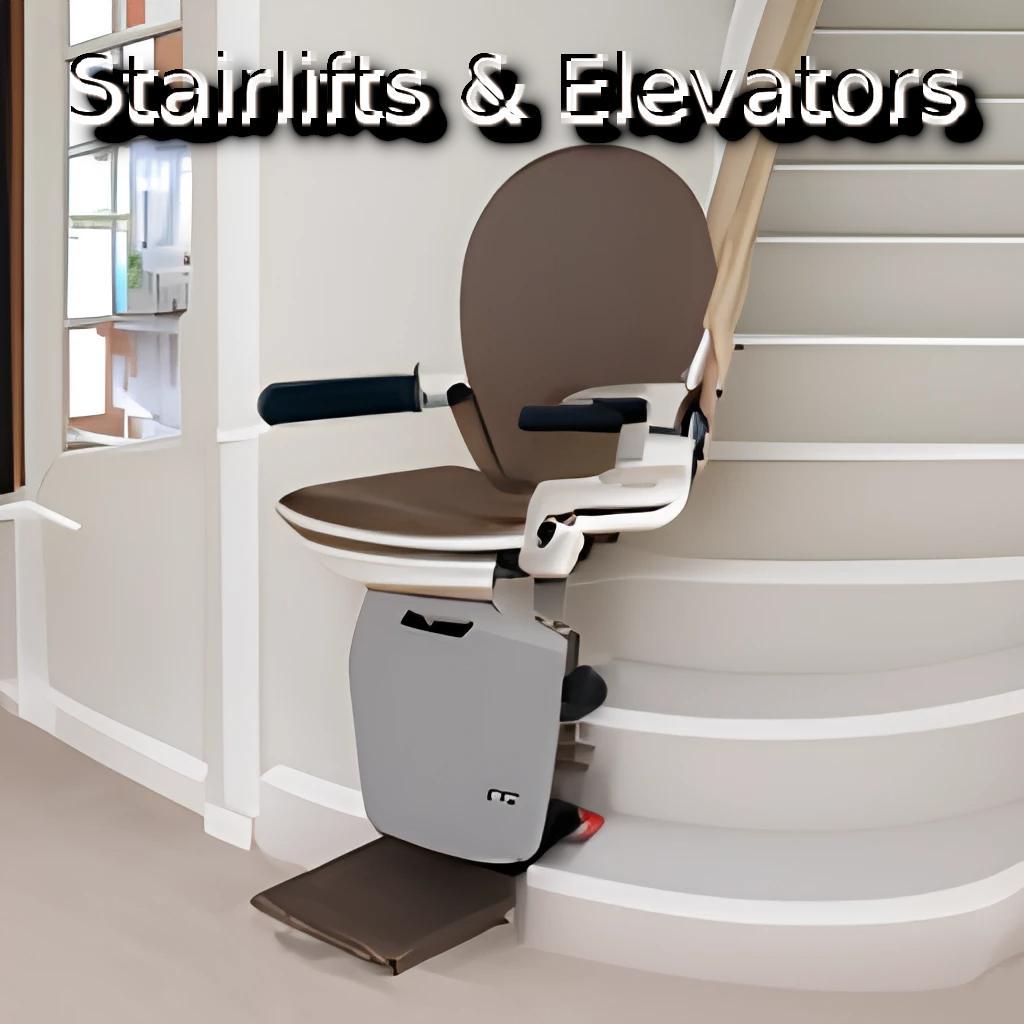


As modern living spaces evolve, so does the need for inclusive and efficient vertical mobility solutions. Elevators and stairlifts stand as technological marvels that enhance accessibility and convenience in homes and buildings. Whether you're considering installing an elevator for multi-level luxury or a stairlift for enhanced mobility, here's a guide with useful tips to navigate the world of vertical transportation.
Elevators: A Vertical Odyssey at Home
Luxury and Functionality: Elevators are no longer exclusive to commercial buildings. Residential elevators now offer a blend of luxury and functionality. Choose an elevator-style that complements your home's aesthetics, whether it's a glass-walled panoramic lift or a discreet, space-saving model.
Space Considerations: Assess your available space when planning for an elevator installation. Home elevators come in various sizes, and careful planning ensures a seamless integration into your home's design. Compact designs and machine-room-less options are available to accommodate different architectural layouts.
Safety Features: Prioritize safety features in your elevator selection. Ensure the elevator is equipped with emergency brakes, battery backup, and a phone or intercom system. Regular maintenance is crucial to keep safety features functioning optimally.
Energy Efficiency: Modern elevators are designed with energy efficiency in mind. Look for models that incorporate energy-saving features, such as LED lighting and regenerative drives. This not only benefits the environment but also contributes to long-term cost savings.
Stairlifts: Ascending with Grace
Tailoring to Your Stairs: Stairlifts are versatile solutions for homes with staircases. When selecting a stairlift, consider the design and configuration of your stairs. Straight stairlifts are suitable for linear staircases, while curved or custom-designed lifts accommodate more complex stair layouts.
User-Friendly Controls: Opt for stairlifts with user-friendly controls. Features like remote controls, swivel seats, and adjustable speed settings enhance the usability and comfort of the lift. Stairlifts are designed to be intuitive, ensuring a smooth and safe ride for users.
Safety Sensors and Seat Belts: Prioritize safety features, including sensors that detect obstacles on the stairs and automatic braking systems. Stairlifts typically come with seat belts or harnesses to secure users during transit. Regular maintenance ensures that safety features are in optimal working condition.
Foldable Design for Space Efficiency: Many stairlifts come with foldable or swiveling designs, allowing the lift to be conveniently folded away when not in use. This ensures that the staircase remains accessible to others and minimizes the visual impact of the lift on your home's aesthetics.
Maintenance and Servicing
Regular Inspection: Both elevators and stairlifts require regular inspections and maintenance. Follow the manufacturer's recommended maintenance schedule to ensure that all components are in proper working condition. Regular servicing not only enhances performance but also extends the lifespan of the equipment.
Emergency Preparedness: Familiarize yourself with emergency procedures for both elevators and stairlifts. Ensure that emergency stop buttons, communication systems, and backup power sources are regularly tested. In the event of a power outage, know the manual operation procedures for your equipment.
Compliance with Regulations
Building Codes and Regulations: Ensure that your elevator or stairlift installation complies with local building codes and regulations. Accessibility standards may vary, and adherence to these guidelines ensures not only the safety of users but also legal compliance.
Permits and Approvals: Check with local authorities to determine whether permits are required for your elevator or stairlift installation. Obtaining the necessary approvals ensures a smooth and lawful installation process.
Stairlifts and elevators are two types of mobility devices that can help individuals with limited mobility move around their homes or other buildings. Here is some more information on each type:
Stairlifts: Stairlifts are devices that are installed on staircases to help individuals who have difficulty climbing stairs. They typically consist of a chair or platform that moves up and down a rail that is attached to the stairs. Stairlifts can be installed on straight or curved staircases and can be customized to fit the specific needs of the user. They can be powered by electricity or batteries, and often include safety features such as seat belts, footrest sensors, and emergency stop buttons. Stairlifts are typically less expensive than elevators and can be installed more quickly and with less disruption to the home.
Elevators: Elevators are devices that provide vertical transportation between floors in a building. They are often used in multi-story homes or buildings and can be customized to fit the specific needs of the user. Elevators can be hydraulic or electric and can be designed for indoor or outdoor use. They are typically more expensive and take longer to install than stairlifts but provide greater flexibility and accessibility. Elevators can also increase the value of a home or building and provide a more convenient and efficient way to move between floors.
Both stairlifts and elevators can greatly improve the mobility and independence of individuals with limited mobility. The choice between the two will depend on the specific needs and circumstances of the individual and their home or building. Consulting with a mobility specialist or installer can help determine the best option for each situation.
The installation of a stairlift or elevator in a building can greatly improve accessibility and mobility for individuals with limited mobility. Here are some general steps involved in the installation process:
Assessment: A mobility specialist or installer will typically visit the building to assess the space and determine the specific needs of the user. They will evaluate factors such as the layout of the building, the type of staircase or shaft, the weight capacity required, and any safety concerns.
Design: Based on the assessment, the installer will design a stairlift or elevator that fits the needs of the user and the building. They will also provide a cost estimate and a timeline for the installation.
Permits and approvals: Depending on the jurisdiction and the type of installation, permits, and approvals may be required from local authorities. The installer will typically handle this process.
Installation: The installation process will vary depending on the type of device and the building. Stairlifts are typically installed within a few hours or days, while elevators may take several weeks or months. The installation process will involve removing any existing structures or fixtures, installing the device, and making any necessary electrical or structural modifications.
Testing and inspection: Once the installation is complete, the installer will test the device to ensure that it is functioning properly and meets all safety standards. They will also schedule any necessary inspections or certifications required by local authorities.
Training and maintenance: The installer will typically provide training on how to use the device safely and effectively. They will also provide information on maintenance and upkeep to ensure that the device continues to function properly over time.
It's important to work with a reputable and experienced installer or mobility specialist when installing a stairlift or elevator. They can help ensure that the device is installed properly, meets all safety standards, and is customized to the specific needs of the user and the building.
Before the installation of a stairlift or elevator in a building, it is important to consider the following factors:
Safety: Safety should be the top priority when installing a mobility device. Ensure that the device meets all safety standards and that the installer has experience and expertise in installing such devices.
Accessibility: Determine the specific accessibility needs of the user, including the height and width requirements, weight capacity, and any other special needs.
Space: Assess the space available for installation, including the size of the staircase or shaft, the available floor space, and any obstructions that may need to be removed.
Building codes: Check local building codes and regulations to ensure that the installation meets all requirements and obtain any necessary permits or approvals.
Cost: Determine the cost of installation, including any ongoing maintenance or repair costs.
Customization: Consider any customization needs for the device, such as the design, color, and control options.
Installer experience: Work with an experienced and reputable installer who has expertise in installing mobility devices and can provide references and certifications.
Finding the right installer or contractor for a stairlift or elevator installation requires some research and due diligence. Here are some steps you can take to find the best installer for your needs:
Ask for referrals: Ask friends, family, or healthcare professionals for referrals to reputable installers or contractors they have worked with before.
Check online directories: Look for directories of local installers or contractors that specialize in stairlift or elevator installations. Check online reviews and ratings to get an idea of the quality of their work and customer service.
Verify credentials: Check that the installer or contractor is licensed, insured, and bonded and that they have experience in installing the specific type of device you need.
Request a consultation: Contact several installers or contractors and request a consultation. This will allow you to meet with them in person, discuss your needs, and get a cost estimate for the installation.
Check references: Ask the installer or contractor for references from previous customers, and follow up with those references to get feedback on their experience.
Compare quotes: Compare quotes from multiple installers or contractors to ensure that you are getting a fair price for the installation.
Elevators and stairlifts are transformative solutions that enhance accessibility and convenience in homes. Whether you're adapting your living space to accommodate changing mobility needs or seeking to add a touch of luxury, careful consideration of design, safety features, and maintenance is key. Elevators and stairlifts, when chosen and maintained thoughtfully, can be more than functional additions—they can be seamless integrations into the fabric of your home, providing a vertical journey with ease and grace.
Yours truly,

We use cookies
We use cookies and other tracking technologies to improve your browsing experience on our website, to show you personalized content and targeted ads, to analyze our website traffic, and to understand where our visitors are coming from. Privacy Policy.